Fifth wheel preventive tips for spring maintenance
After a winter withstanding ice, snow, and corrosive road deicers, several truck components need a bit of spring maintenance, and fifth wheels are no different. You could argue they are at the top of importance, considering they impact both the tractor and trailer. To help the industry understand what to focus on, Dan Henderson, tech service coordinator for Fontaine Fifth Wheel, recently outlined what areas to inspect and lubricate on a Fontaine fifth wheel to ensure your tractor-trailers are ready for the busier warmer months.
Under the hood (or plate)
For fifth wheels, technicians must go beneath the truck and check the mechanisms beneath the plate, Henderson explained. This includes verifying that all three springs, including the bumper and timer spring, are all properly attached. Additionally, make sure that the pull handle for manually activating the locks is straight. And if the handle is bent, replace it instead of attempting to straighten it.
Henderson warned overstraightening by an inch or more, "your secondary lock is gonna be pulled away from the side of the fifth wheel."
Additionally, technicians and drivers must check that the primary and secondary locks are working properly and that the nut on the adjustment rod is functional. Lubricating the fifth wheel’s pivot points is critical as well, including the pivot points of the secondary lock, the bumper, and the operating handle.
“It is important to make sure that these are lubricated in order for the fifth wheel to operate properly and for the long-lasting of the bushings,” the technical service coordinator explained.
In particular, make sure that the kingpin hasn’t struck the operating handle area and settled on top of the fifth wheel.
“If the kingpin has struck this area and crushed in the side of the fifth wheel, it can keep the fifth wheel from operating,” Henderson explained.
Lubrication techniques
Pivot points aren’t the only places that should be lubricated for spring operation. Technicians also need to grease the top plate and locks, too. To do this, be sure to clean the top plate so that you can inspect both it and the plate sides for cracks and stress damage. Additionally, make sure the grease grooves on the top plate are clean, and then apply about ½” of grease above these areas. Then take a scraper or a piece of cardboard and spread the grease evenly halfway up the ramp, and lightly lubricate the center area as well.
Read more: Fontaine introduces first fifth wheel 'with a brain'
Henderson noted that technicians should inspect the void area on the top plate that keeps the convexed trailer plate from center-loading the fifth wheel, which would cause it to flex.
“If you're seeing wear in this area, you've definitely got a bad trailer plate,” Henderson emphasized. “It can cause the kingpin to protrude too far down through into the fifth wheel throat and not make contact with the trigger to close the fifth wheel, and it can also cause the upper collar of the kingpin to hang up on the locks.”
Additionally, be sure to check the trailer lock serrations and apply grease on the locks, too. To inspect the lock ‘teeth,’ use the pull handle to open the locks a small amount, then run a screwdriver along the inside of the locks, where you should be able to feel and hear the teeth within.
Then, apply grease between the locks, along the back side of the wedge, in the cut of the jaw, and on the stationary jaw. Keep in mind that these areas don’t need a lot of grease, and use the pull handle to move the locks back and forth to fully distribute the lubrication.
Additional inspection items
Finally, use a kingpin tool to make sure the fifth wheel is functioning properly. Insert the kingpin tool into the fifth wheel’s throat, which should cause the fifth wheel to close. Make sure that the handle is within an inch of the side skirt of the fifth wheel when it is fully closed, and check the adjustment rod’s calibration with your thumb. You’re looking for free play of about ¼”, Henderson said.
Additionally, always check the fifth wheel bracket to make sure that all of the bolts on the outboard angles are present and undamaged.
“The DOT will put you on the side of the road if all of these bolts are not in,” Henderson warned.
Additionally, make sure to check the springs, cylinder, and linkage for any bending or damage, and actuate the cylinder to make sure it’s working properly. You can also use a screwdriver to ensure that the bracket liner isn’t too worn – once you pop the liner off of its seating, make sure that it is at least 1/8” thick at the center, Henderson explained.
After that, ensure that the fifth wheel’s bushings and linkage are still intact.
With these tactics, fleets can make sure that their fifth wheels are ready for warmer weather, keeping both their customers' cargo, and the roads, safer at the same time.
About the Author

Alex Keenan
Alex Keenan is an Associate Editor for Fleet Maintenance magazine. She has written on a variety of topics for the past several years and recently joined the transportation industry, reviewing content covering technician challenges and breaking industry news. She holds a bachelor's degree in English from Colorado State University in Fort Collins, Colorado.


